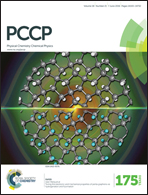Are the current theories of electron transfer applicable to reactions in ionic liquids? An ESR-study on the TCNE/TCNE−˙ couple
Abstract
Chemical reactivity is profoundly affected by solvent properties. Room temperature ionic liquids (RTILs) obtain molecular environments that differ vastly from those established using molecular solvents with comparable macroscopic properties. In particular, charges are expected to be completely shielded in RTILs even though their dielectric constants are typically low. This raises the question whether electron transfer (ET) reactions in RTILs can be described in terms of Marcus' theory, a model that is fundamentally based on continuum dielectric theory. Herein, we elucidate this question by studying a degenerate electron transfer process, which by design, is not affected by ambiguities in the driving force of the reaction and thus allows a clear-cut assessment of the ET activation energy. We report the rate constants and the activation parameters of the electron self-exchange reaction in the TCNE/TCNE˙− couple in seven ionic liquids. The exchange rate constants range from 5.4 × 107 M−1 s−1 to 9.1 × 108 M−1 s−1 at 330 K and the activation energies vary from 14 kJ mol−1 to 41 kJ mol−1. The results are discussed in the framework of Marcus' theory. It is found that the solvent dependence of the rate constants cannot be described by the classical proportionality to the Pekar factor γ = (1/n2 − 1/εs).


 Please wait while we load your content...
Please wait while we load your content...